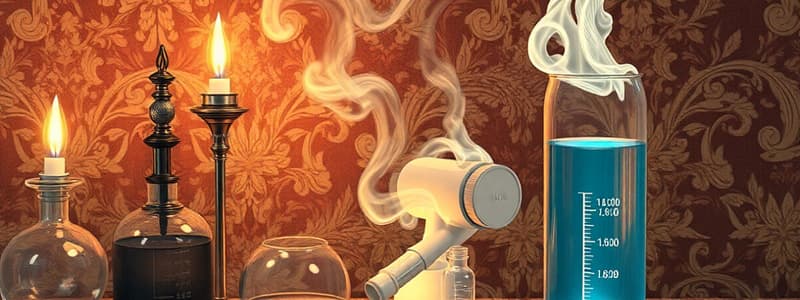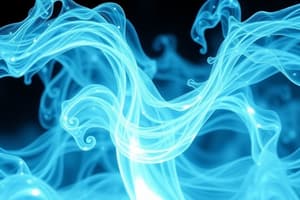Podcast
Questions and Answers
What is the SI unit of pressure for gases?
What is the SI unit of pressure for gases?
- Pascal (correct)
- Newtons per metre squared (correct)
- Kelvin
- Cubic metre
Boyle’s Law states that at constant temperature, the volume of a gas is directly proportional to its pressure.
Boyle’s Law states that at constant temperature, the volume of a gas is directly proportional to its pressure.
False (B)
What is the value of standard temperature in Kelvin?
What is the value of standard temperature in Kelvin?
273 K
At absolute zero, the temperature in Kelvin is _____ K.
At absolute zero, the temperature in Kelvin is _____ K.
Match the following units with their corresponding quantities:
Match the following units with their corresponding quantities:
Which gas law describes the relationship between the volume and pressure of a gas at constant temperature?
Which gas law describes the relationship between the volume and pressure of a gas at constant temperature?
A gas fills the entire volume of its container uniformly.
A gas fills the entire volume of its container uniformly.
What is the relationship between volume and pressure in Boyle's Law?
What is the relationship between volume and pressure in Boyle's Law?
Which of the following is NOT an assumption of the kinetic theory of gases?
Which of the following is NOT an assumption of the kinetic theory of gases?
The average kinetic energy of gas molecules is independent of temperature.
The average kinetic energy of gas molecules is independent of temperature.
What is the equation representing the state of an ideal gas?
What is the equation representing the state of an ideal gas?
According to the kinetic theory of gases, gas particles are in continuous rapid, random ______.
According to the kinetic theory of gases, gas particles are in continuous rapid, random ______.
Match the following properties with their definitions:
Match the following properties with their definitions:
What must be true about the units when using the equation pV = NRT?
What must be true about the units when using the equation pV = NRT?
Attractive forces between gas molecules can be ignored under all conditions.
Attractive forces between gas molecules can be ignored under all conditions.
What is the universal gas constant represented by (R)?
What is the universal gas constant represented by (R)?
What does Boyle’s Law express about the relationship between pressure and volume of a gas?
What does Boyle’s Law express about the relationship between pressure and volume of a gas?
Charles' Law indicates that the volume of a gas decreases with an increase in temperature at constant pressure.
Charles' Law indicates that the volume of a gas decreases with an increase in temperature at constant pressure.
What is the mathematical expression for Charles' Law?
What is the mathematical expression for Charles' Law?
The temperature at which the volume of gas reaches zero is known as _______.
The temperature at which the volume of gas reaches zero is known as _______.
Match the following terms with their definitions:
Match the following terms with their definitions:
At what temperature does the volume of gas theoretically become zero according to the behavior described?
At what temperature does the volume of gas theoretically become zero according to the behavior described?
According to Charles' Law, if the pressure is held constant, increasing temperature results in a decrease in volume.
According to Charles' Law, if the pressure is held constant, increasing temperature results in a decrease in volume.
What happens to the volatile liquid in the flask during the heating process?
What happens to the volatile liquid in the flask during the heating process?
What is the significance of the point where the volume-temperature line intersects the X-axis?
What is the significance of the point where the volume-temperature line intersects the X-axis?
The atmospheric pressure inside the flask will always be greater than the vapor pressure of the volatile liquid.
The atmospheric pressure inside the flask will always be greater than the vapor pressure of the volatile liquid.
What liquid is mentioned as suitable to use in this experiment?
What liquid is mentioned as suitable to use in this experiment?
To determine the mass of the vapor, subtract the mass of the _____ from the mass of the flask with the vapor.
To determine the mass of the vapor, subtract the mass of the _____ from the mass of the flask with the vapor.
Match the steps to the correct procedure in determining the mass and volume of the vapor.
Match the steps to the correct procedure in determining the mass and volume of the vapor.
What equipment is necessary to record atmospheric pressure?
What equipment is necessary to record atmospheric pressure?
The volume of vapor can be determined by measuring the water displaced in a graduated cylinder.
The volume of vapor can be determined by measuring the water displaced in a graduated cylinder.
At what temperature and pressure does the vapor of the volatile liquid occupy a volume of 330 cm³?
At what temperature and pressure does the vapor of the volatile liquid occupy a volume of 330 cm³?
What is the correct formula used to calculate the number of moles (n) of a gas?
What is the correct formula used to calculate the number of moles (n) of a gas?
The average kinetic energy of gas molecules is not proportional to the Kelvin temperature.
The average kinetic energy of gas molecules is not proportional to the Kelvin temperature.
How many moles of gas are present in 1.8 × 10^24 atoms of chlorine at standard temperature and pressure?
How many moles of gas are present in 1.8 × 10^24 atoms of chlorine at standard temperature and pressure?
A mass spectrometer is an instrumental technique used for measuring the relative molecular mass of both __________ and __________ substances.
A mass spectrometer is an instrumental technique used for measuring the relative molecular mass of both __________ and __________ substances.
Match the following concepts to their descriptions:
Match the following concepts to their descriptions:
What is the Combined Gas Law formula?
What is the Combined Gas Law formula?
Avogadro's Law states that equal volumes of gases contain different numbers of molecules under the same conditions of temperature and pressure.
Avogadro's Law states that equal volumes of gases contain different numbers of molecules under the same conditions of temperature and pressure.
What is the molar volume of any gas at standard temperature and pressure (s.t.p)?
What is the molar volume of any gas at standard temperature and pressure (s.t.p)?
The equation for Boyle's Law is represented as $pV = ______$.
The equation for Boyle's Law is represented as $pV = ______$.
In the Combined Gas Law, if pressure increases while temperature remains constant, what happens to the volume?
In the Combined Gas Law, if pressure increases while temperature remains constant, what happens to the volume?
Gay-Lussac’s Law of Combining Volumes indicates that the volumes of reacting gases can be in any ratio.
Gay-Lussac’s Law of Combining Volumes indicates that the volumes of reacting gases can be in any ratio.
When hydrogen reacts with oxygen, the resulting product is ______.
When hydrogen reacts with oxygen, the resulting product is ______.
Flashcards
Gas Definition
Gas Definition
A gas is a substance with no fixed boundaries that rapidly fills its container.
Temperature (Celsius)
Temperature (Celsius)
A measure of hotness, using a scale where freezing point of water is 0°C and boiling point is 100°C.
Temperature (Kelvin)
Temperature (Kelvin)
A temperature scale where 0K is absolute zero.
Boyle's Law
Boyle's Law
Signup and view all the flashcards
Pressure Unit
Pressure Unit
Signup and view all the flashcards
Volume Unit
Volume Unit
Signup and view all the flashcards
STP (Standard Temperature & Pressure)
STP (Standard Temperature & Pressure)
Signup and view all the flashcards
Inverse Relationship (Boyle's Law)
Inverse Relationship (Boyle's Law)
Signup and view all the flashcards
Charles' Law
Charles' Law
Signup and view all the flashcards
Absolute Zero
Absolute Zero
Signup and view all the flashcards
Kelvin Scale
Kelvin Scale
Signup and view all the flashcards
pV = k
pV = k
Signup and view all the flashcards
V/T = k
V/T = k
Signup and view all the flashcards
Direct Proportion
Direct Proportion
Signup and view all the flashcards
Inverse Proportion
Inverse Proportion
Signup and view all the flashcards
Kinetic Theory of Gases
Kinetic Theory of Gases
Signup and view all the flashcards
Ideal Gas
Ideal Gas
Signup and view all the flashcards
Assumptions of Kinetic Theory
Assumptions of Kinetic Theory
Signup and view all the flashcards
Elastic Collisions
Elastic Collisions
Signup and view all the flashcards
Average Kinetic Energy
Average Kinetic Energy
Signup and view all the flashcards
Equation of State (Ideal Gas)
Equation of State (Ideal Gas)
Signup and view all the flashcards
Pressure (P)
Pressure (P)
Signup and view all the flashcards
Volume (V)
Volume (V)
Signup and view all the flashcards
Combined Gas Law
Combined Gas Law
Signup and view all the flashcards
What is the Combined Gas Law Equation?
What is the Combined Gas Law Equation?
Signup and view all the flashcards
Gay-Lussac's Law of Combining Volumes
Gay-Lussac's Law of Combining Volumes
Signup and view all the flashcards
What are the conditions for Gay-Lussac's Law?
What are the conditions for Gay-Lussac's Law?
Signup and view all the flashcards
Avogadro's Law
Avogadro's Law
Signup and view all the flashcards
Molar Volume
Molar Volume
Signup and view all the flashcards
What is the molar volume at room temperature and pressure?
What is the molar volume at room temperature and pressure?
Signup and view all the flashcards
Volatile Liquid
Volatile Liquid
Signup and view all the flashcards
Vaporization
Vaporization
Signup and view all the flashcards
Condensation
Condensation
Signup and view all the flashcards
Atmospheric Pressure
Atmospheric Pressure
Signup and view all the flashcards
Relative Molecular Mass (Mr)
Relative Molecular Mass (Mr)
Signup and view all the flashcards
Mass of Vapour Determination
Mass of Vapour Determination
Signup and view all the flashcards
Volume of Vapour Determination
Volume of Vapour Determination
Signup and view all the flashcards
Why Vapour Pressure = Atmospheric Pressure
Why Vapour Pressure = Atmospheric Pressure
Signup and view all the flashcards
Kinetic Theory Assumptions
Kinetic Theory Assumptions
Signup and view all the flashcards
Ideal Gas vs. Real Gas
Ideal Gas vs. Real Gas
Signup and view all the flashcards
Calculate Moles from Atoms
Calculate Moles from Atoms
Signup and view all the flashcards
Non-Volatile Liquids
Non-Volatile Liquids
Signup and view all the flashcards
Study Notes
Gas Properties
- A gas is a substance with no defined boundaries and rapidly fills any container.
- Gases are one of the three states of matter (solid, liquid, gas).
Gas Laws: Temperature
- Temperature measures the hotness of an object.
- Kelvin scale: -273°C is absolute zero.
- Celsius scale: Water freezes at 0°C and boils at 100°C.
- To convert Celsius to Kelvin, add 273.
Gas Laws: Pressure
- Pressure is the force a gas exerts on a unit area.
- Measured in Newtons per meter squared (N/m²), also called Pascals (Pa).
- Normal atmospheric pressure is 1 x 10⁵ Pa or 100,000 Pa.
- Also expressed in kilopascals (kPa) and hectopascals (hPa).
Gas Laws: Volume
- Volume is the space occupied by a gas, equivalent to the container's volume.
- Measured in cubic meters (m³), cubic centimeters (cm³), or liters (L).
- 1 liter = 1000 cm³ = 1 cubic decimeter (dm³).
Gas Laws: Standard Temperature and Pressure (STP)
- Standard temperature: 273 K.
- Standard pressure: 100,000 Pa.
Boyle's Law
- At constant temperature, the volume of a fixed mass of gas is inversely proportional to its pressure.
- pV = k (where p is pressure, V is volume, and k is a constant)
- Boyle experimentally confirmed this inverse relationship.
Charles' Law
- At constant pressure, the volume of a fixed mass of gas is directly proportional to its temperature (measured in Kelvin).
- V/T = k (where V is volume, T is temperature, and k is a constant)
- Charles found that the relationship is linear when temperature is plotted against volume.
Combined Gas Law
- Combines Boyle's and Charles' laws.
- (P₁V₁)/T₁ = (P₂V₂)/T₂ (where subscripts 1 and 2 represent initial and final conditions)
Gay-Lussac's Law of Combining Volumes
- In gas reactions, the volumes of reacting gases and the gaseous products are in ratios of whole numbers when measured at the same temperature and pressure.
Avogadro's Law
- Equal volumes of gases at the same temperature and pressure contain equal numbers of molecules.
- At STP (Standard Temperature and Pressure), one mole of any gas occupies 22.4 liters.
Kinetic Theory of Gases
- Gases are composed of tiny, rapidly moving particles in random motion.
- Interactions between particles are negligible except for collisions.
- The average kinetic energy of the particles is proportional to the absolute temperature (in Kelvin).
Studying That Suits You
Use AI to generate personalized quizzes and flashcards to suit your learning preferences.




